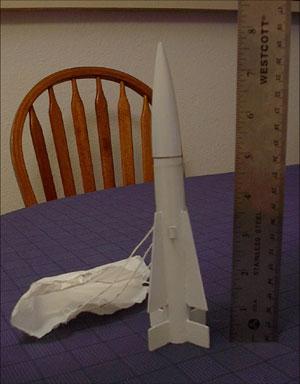| Manufacturer: | Scratch |
 Brief:
Brief:
This is a Phoenix built from 4x downscaling the original Estes kit. It is much less expensive to fly as it uses 18mm motors and 1 sheet of wadding or less, compared to the original using 24mm motors and 14 sheets of wadding.
Construction:
- Nose Cone - Reliant/Viking BT-20 (filled with modelling clay)
- Custom 7" parachute made from a shopping bag
- Custom 7" shock cord made from 2 rubber bands
- 2 Sets of 4 fins each made from 1/16" balsa
- 1/8" end section of spent A engine motor (engine block)
- 1/4" long 1/8" launch lug
This design took about 2 days to assemble. This is the second one of these rockets that I've built. The original used dual 4" chutes, and I painted some of the details onto it which I omitted from this design.
I started by cutting 1/8" off the ejection charge end of a spent A8-3. I used this to make the engine block. With another used engine, I pushed the engine block into the body tube until there was 1/8" of overhang from the end of the tube.
I used 1/16" balsa to make the fins. The angled edge of the front fin set needs to be aligned with the edge of the balse sheet when drawing the fins. Otherwise, the fins will split when you cut them out. I used a 1/4" length of Estes' standard 1/8" diameter launch lug.
I filled the entire nose cone with modelling clay (~14g). This placed the center of gravity of the unloaded rocket at the top end of the body tube. This allows the rocket to be stable for A-C engines. The center of gravity should be at the top of the front fin set.
I used a plastic shopping bag to make a parachute about 7" in diameter. I used cotton string for the shroud lines (this was cheap and available). I didn't have any 1/8" elastic, so I tied two rubber bands together for the shock cord. I mounted the shock cord to part of an index card with white glue.
Flight:
Rocket #1
1. A8-3 Stability Test #1
The rocket flew relatively straight. Apogee was difficult to determine from about 500' away. The chutes deployed but weren't really big enough to do any good. No damage.
2. B6-4 Stability Test #2
The rocket still flew straight. And I thought the first one went high. It came down in the trees, but it was so small that it fell right through the branches without getting caught. The heavy nosecone also helped.
3. C6-7 Orbital Test
The rocket flew straight for 500 feet or so. Then it turned into the wind and was lost from sight. We saw the smoke trail around 1700 ft. or so down range. I guess you can't really distinguish an 8 inch rocket from the sky at that point. No idea whether the parachutes deployed. It probably landed somewhere.
Rocket #2
1. A8-3
This one flew straight to about 500 feet. The parachute opening and was only scorched a little. I used less than 1/2 sheet of wadding, and I stuffed it into the engine itself.
Summary:
PROS: Cheap to build and fly. Goes to high altitudes with larger engines.
CONS: Turns into the wind a little with C engines and disappears from sight.
Related Products
 |
 |